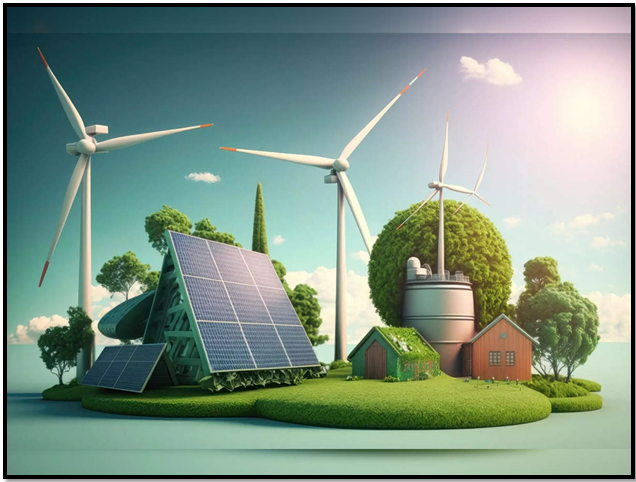HURDLES ON PATH TO GREEN
SYLLABUS:
- GS 2: Conservation, environmental pollution and degradation, environmental impact assessment.
Focus:
- The recent heatwave has reminded us of the stark risks posed by climate change and highlighted the criticality of the efforts taken by the Conference of Parties (COP).
Source: Economics Times
The recent heatwave has starkly reminded us of the urgent need to address climate change. With 2023 recorded as the warmest year on record by the World Meteorological Organization, the focus has intensified on high-emission sectors such as power, steel, cement, chemicals, fertilizers, and refineries. India, as the third-largest carbon emitter, faces significant challenges and opportunities in transitioning to green technology. While the government has introduced various initiatives to support this shift, achieving climate goals will require overcoming numerous hurdles, substantial investments, and unwavering government support.
Government Support and Initiatives
- Renewable Energy (RE) Sector Initiatives: The government has launched the Production Linked Incentive (PLI) scheme to boost solar module manufacturing, aiming to increase the adoption of renewable energy.
- Funding Schemes: Viability gap funding schemes have been introduced for offshore wind and battery storage projects, supporting the infrastructure needed for renewable energy sources.
- Electric Vehicle Promotion: The Faster Adoption & Manufacturing of Electric Vehicles (FAME) scheme encourages the use of electric vehicles, reducing dependence on fossil fuels.
- Green Hydrogen Mission: The National Green Hydrogen Mission promotes the use of green hydrogen in refining, chemical, and fertilizer sectors, aiming to reduce carbon emissions significantly.
- Legislative Support: Amendments to the Energy Conservation bill and the launch of green bonds provide a legislative and financial framework to support green energy projects.
Transition Risks for Entities
- Policy Risks: Entities must navigate changing regulations and government policies aimed at promoting green technology.
- Regulatory Risks: Compliance with new environmental standards and laws presents challenges for industries transitioning to green technology.
- Technological Risks: The adoption and integration of new green technologies pose significant immediate risks.
- Market Risks: Changes in market demand and competition related to green products and services can affect business operations.
- Reputational Risks: Maintaining a positive public image regarding environmental responsibility is crucial for entities undergoing green transformation.
Investment Requirements
- Renewable Energy Investments: Achieving India’s climate goals necessitates Rs 11-12 lakh crore in renewable energy power investments by 2030.
- Infrastructure Investments: Over Rs 5-6 lakh crore will be required for transmission infrastructure and storage capabilities to support renewable energy.
- Hybrid Projects and Storage Systems: Investments in hybrid renewable energy projects and energy storage systems are essential for ensuring a stable energy supply.
- Carbon Sequestration: Hard-to-abate sectors like steel and cement will need to invest in carbon capture utilization and storage (CCUS) to reduce emissions.
- Cement Sector CCUS: The cement sector will require two million tonnes per annum of CCUS capacity by 2030, with a capital cost of Rs 1,600-1,800 crore.
Sector-Specific Challenges
- Cement Manufacturing: The cement manufacturing process is highly resource and energy-intensive, releasing significant carbon dioxide emissions.
- Emissions Reduction: CCUS can reduce more than 60-70% of emissions in the cement manufacturing process, making it essential for the sector.
- Steel Industry: The domestic steel industry relies heavily on coal due to abundant virgin iron ore and limited domestic scrap, contributing to high emissions.
- Technological Interventions: India’s steelmakers aim to reduce their carbon footprint by 25-30% through technological advancements by 2030.
- Green Hydrogen Usage: Green hydrogen usage is planned in refining, chemical, and fertilizer sectors, with an estimated capex of Rs 8-9 lakh crore, to reduce carbon emissions.
Conclusion
The path to achieving India’s climate goals is fraught with challenges and requires significant investments and technological advancements. While the government has taken commendable steps through various initiatives, continuous and enhanced support is crucial. Policy interventions, subsidies, duty exemptions, and tax benefits can accelerate the transition to green technology in high-emission sectors. The collaboration between government and industry stakeholders will be vital in overcoming the hurdles on the path to a sustainable and green future.
| Key Terms and Organizations
Conference of Parties (COP)
National Green Hydrogen Mission
Carbon Capture Utilization and Storage (CCUS)
|
Source:Indian Express
Mains Practice Question:
Heatwaves have become increasingly frequent and intense due to climate change, posing significant risks to public health, agriculture, and infrastructure. Discuss the causes, impacts, and measures to mitigate the effects of heatwaves in India.
Associated Articles:
https://universalinstitutions.com/a-green-development-paradigm/




